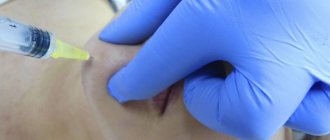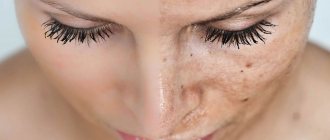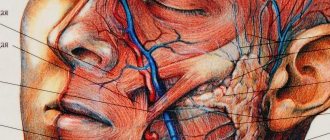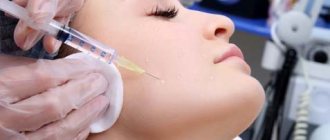There are many types of mesotherapy, thanks to which girls effectively combat various skin problems, regardless of the cause of their occurrence. Drainage mesotherapy of the face is aimed at eliminating swelling of tissues and restoring their water balance. Thanks to this effect, not only their external condition is transformed, but also the internal microflora improves.
Features of drainage mesotherapy
Drainage mesotherapy is a minimally invasive procedure, the essence of which is the introduction of special preparations into the structure of the dermis. Their effect is mainly aimed at improving the internal microflora of the skin.
Mesotherapy allows you to remove excess intercellular fluid from the skin, thereby reducing its volume and swelling. In addition, the technique helps awaken internal processes that slow down with age:
- Activation of collagen and elastin production;
- Acceleration of epithelial cell regeneration;
- Normalization of blood microcirculation;
- Restoration of metabolism;
- Restoring water balance.
In addition, due to the high permeability of the meso-cocktails used, they quickly saturate the epithelial cells, eliminating deficiencies of vitamins and minerals in them.
Useful video
Watch this video about non-surgical nose shape correction:
Similar articles
- Lipolytic mesotherapy for face and body
A worthy alternative to surgical removal of excess fat is lipolytic mesotherapy. Its essence comes down to the fact that special cocktails are injected under the skin of the face or body to break down fat cells. Read more - Care after mesotherapy: what you need for your face after...
Proper care after mesotherapy will ensure a minimum of negative consequences. In general, it is almost the same for fractional, injection and non-injection procedures, however, after the first two, it is necessary to additionally treat facial skin punctures at home. Read more
- Mesotherapy without injections: features of carrying out without...
For those who do not want to injure the skin with injections, mesotherapy without injections is ideal. Basically, three types of cocktails are selected for the face - with hyaluric acid, vitamin C, and peptides. A non-invasive facial procedure is slightly less effective than one with injections, but more gentle. Read more
- Mesotherapy: contraindications for the face, hair, head...
Although mesotherapy is useful for most skin problems, contraindications can become a serious obstacle to the procedure. There are both general to fractional, non-injection, and local for the face, hair, and body. Read more
- Mesotherapy for cellulite: how is the treatment…
One of the most effective procedures is mesotherapy for cellulite. It provides skin treatment, not just a visual effect. Body preparations are selected individually. It can be non-injection, fractional, hardware for the hips. The results before and after even the first session will not be long in coming. Read more
Indications for use
Drainage mesotherapy, unlike conventional technology, is not aimed at skin rejuvenation, but at eliminating swelling and increased fluid accumulation in tissues.
Because of this, other indications for the procedure are prescribed:
- Double chin.
- Low skin tightness.
- Fuzzy oval face.
- Swelling – in the area of the eyelids, cheeks, cheekbones, forehead, lips or chin.
- Ptosis of the skin.
- Large reliefs - wrinkles, stretch marks, creases.
Thanks to drainage mesotherapy, skin tone is gradually restored. It becomes firmer and more elastic, thanks to which you may also notice some rejuvenating effect of the technique.
When is fold correction needed?
The condition of the nasolabial triangle is influenced by several factors.
The most pronounced folds become in those people who have pronounced facial expressions, do not regularly take care of their face, live in a harmful external environment, suffer from bad habits, and diseases of internal organs. The use of special cosmetics and massage help slow down aging, but do not solve the underlying problem. The main method of restoring the condition of nasolabial folds in cosmetology is mesotherapy. It gives an excellent effect and long-lasting results.
Contraindications to drainage mesotherapy
Since drainage mesotherapy is performed by injection and violates the integrity of the skin in the treated area, some restrictions are prescribed for health reasons:
- Diabetes;
- Low skin coagulability;
- Pregnancy, lactation;
- Fungus;
- Skin lesions;
- Fungus;
- Tumor;
- Diseases of the cardiovascular system;
- Individual intolerance to mesococktail components.
To make sure that you are not allergic to the drug, first apply it to a small area of skin for 20-30 minutes, then rinse off and monitor the skin reaction for 1-2 days.
It is important to pay attention to contraindications to mesotherapy in order to avoid complications and reduce the effectiveness of the technique.
Efficiency of the technique
To restore the collagen framework and facial architecture, a course of 5-10 procedures is recommended.
Each session forces the body's cells to mobilize their own resources to fight wrinkles, sagging, skin inflammation and other problems.
The result does not take long to arrive: after microinjections, the quality and appearance of the epidermis improves significantly: shallow wrinkles are straightened, acne goes away, an even color is restored, and the density and hydration of the skin increases.
Everyone notices significant rejuvenation, which can then be maintained with short courses once or twice a year.
Since the late 90s of the last century, mesotherapy has been officially recognized as a branch of European medicine.
The first injections of medicinal value were made in France, where this method was invented. Research by scientists has shown that the micro-point effect of injections into the patient’s mesoderm effectively solves a number of physiological and cosmetic problems.
Cocktails and preparations for the procedure
Cocktails used for mesotherapy can be divided into two main types:
- Lipolitics. Activate blood microcirculation and promote the removal of excess fatty tissue from cells.
- Venotonics. They help to activate venous activity and restore the integrity of blood vessels and capillaries, which reduce the amount of fatty deposits and fluid due to drainage.
Most often, the second version of the composition is used for drainage mesotherapy, since it more effectively combats water imbalance in tissues and fluid retention in them.
In addition to the main active ingredients, venotonics include the following useful components:
- Vitamins;
- Minerals;
- Organic acids;
- Animal and plant extracts;
- Oils;
- Coenzymes;
- Hyaluronic acid.
Most often, meso-cocktails do not contain toxic and aggressive components that could adversely affect skin health.
Efficiency of the technique
To restore the collagen framework and facial architecture, a course of 5-10 procedures is recommended.
Each session forces the body's cells to mobilize their own resources to fight wrinkles, sagging, skin inflammation and other problems.
The result does not take long to arrive: after microinjections, the quality and appearance of the epidermis improves significantly: shallow wrinkles are straightened, acne goes away, an even color is restored, and the density and hydration of the skin increases.
Everyone notices significant rejuvenation, which can then be maintained with short courses once or twice a year.
Since the late 90s of the last century, mesotherapy has been officially recognized as a branch of European medicine.
The first injections of medicinal value were made in France, where this method was invented. Research by scientists has shown that the micro-point effect of injections into the patient’s mesoderm effectively solves a number of physiological and cosmetic problems.
Technique for a slim face
Before performing drainage mesotherapy, the master always inspects the work area, cleans it of cosmetics and dirt, and also treats it with a disinfectant solution of Chlorhexidine.
Then a syringe with a thin cosmetic needle is filled with the selected meso-cocktail, and the procedure itself begins:
- The skin in the injection area is slightly stretched, and then a needle is quickly inserted into it, penetrating to a depth of 5-10 mm.
- The drug is slowly introduced into the structure of the dermis, after which the needle is removed.
- A small cotton compress with an antiseptic is immediately applied to the puncture area.
- In this way, the girl’s entire face and especially the problem areas on it are gradually processed. Typically, a cosmetologist creates 7-8 punctures in different places during a session.
- After mesotherapy is completed, excess drug is removed and the skin is treated with a disinfectant solution of Chlorhexidine.
- A soothing anti-inflammatory lotion is applied.
Typically, a drainage mesotherapy session lasts no more than 20-30 minutes, and during it the girl does not feel much discomfort or pain, which is why painkillers are not usually used.
However, at any time you can ask the cosmetologist to pre-apply an anesthetic at a lower pain threshold in order to avoid unpleasant sensations.
Efficiency of the technique
To restore the collagen framework and facial architecture, a course of 5-10 procedures is recommended.
Each session forces the body's cells to mobilize their own resources to fight wrinkles, sagging, skin inflammation and other problems.
The result does not take long to arrive: after microinjections, the quality and appearance of the epidermis improves significantly: shallow wrinkles are straightened, acne goes away, an even color is restored, and the density and hydration of the skin increases.
Everyone notices significant rejuvenation, which can then be maintained with short courses once or twice a year.
Since the late 90s of the last century, mesotherapy has been officially recognized as a branch of European medicine.
The first injections of medicinal value were made in France, where this method was invented. Research by scientists has shown that the micro-point effect of injections into the patient’s mesoderm effectively solves a number of physiological and cosmetic problems.
Care during the recovery period
Despite the safety and gentle effect of mesotherapy on the skin, its essence lies in creating mechanical punctures on the skin that violate its integrity.
Because of this, after each session it is important for the girl to observe some precautions and prohibitions:
- For 4 hours, refrain from washing your face and applying any cosmetics to the treated area;
- Stop smoking and drinking alcohol and energy drinks for 6 hours;
- For three days, avoid visiting the bathhouse, sauna, swimming pool, or taking hot baths;
- Stop taking blood thinning medications and do not sunbathe while taking a course of mesotherapy. It is recommended to use sunscreen and lotions before going outside on a sunny day.
It is also not recommended to subject the body to serious physical activity during the first 2-3 days. This is due to the fact that sport stimulates metabolic processes in tissues and activates the active work of the sebaceous glands, which can negatively affect the effectiveness of the procedure.
It is important to follow the prescribed restrictions and prohibitions after each visit to cosmetology, so that the skin has time to recover and prepare for the subsequent administration of the compositions.
Will it help to make your nose smaller?
Procedures to correct nasal imperfections are very popular. This is the most characteristic and outstanding feature of the face. To make your nose thinner and more graceful, you don’t have to go under the surgeon’s knife. If a person is not satisfied with the shape and size, then the problem can be corrected using mesotherapy.
To make it thinner and more graceful, drugs with a drainage effect are used to make the nose smaller. They remove excess fluid and lipid deposits, as a result the wings, back and tip become more aristocratic. The effect lasts for a long time. The procedure is practically painless and entails a minimum of complications.
The result of nasal mesotherapy is usually already noticeable after the first session. The doctor prescribes the number of procedures depending on individual characteristics. On average, the course consists of 2-3 sessions with an interval of 7-10 days.










